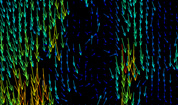|
Particle Image Velocimetry
Two-dimensional velocity measurements are made in a particle laden flow. A double pulsed laser sheet illuminates a two dimensional particle field. An imaging device takes a picture of the double exposed individual particles. Given a known pulse separation and a measured particle image separation, velocity values across the plane may be determined.
Typical Accuracy:
~5%
Requirements:
- Ninety Degree Dual Optical Access
- Seeding
- Image Processing
Select Wind Tunnels:
- BART
- Counter Flow Diffusion Flame
- Water Tunnel
- Mach 6 Tunnel
- Backward Facing Step
Potential Extensions:
We are currently examining Holographic PIV. This will allow the user to obtain three dimensional three component velocity data. Laboratory results look very promising.
Primary Limitations of PIV:
- Seeding
- Two-dimensional (potential for holographic recording)
Primary Advantages of PIV:
- Maturity
- Planar Measurements
|




